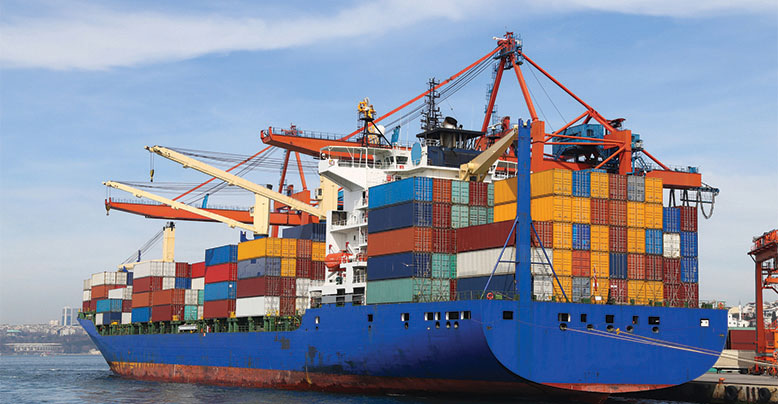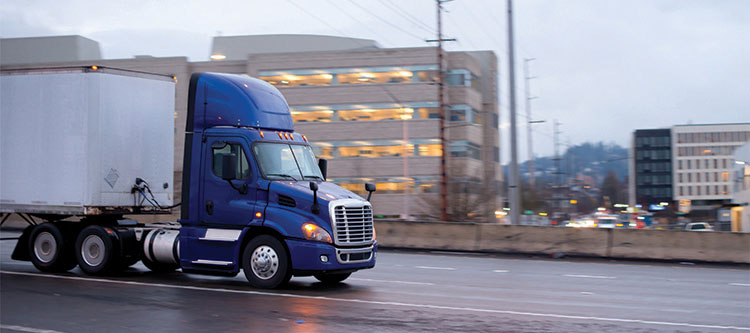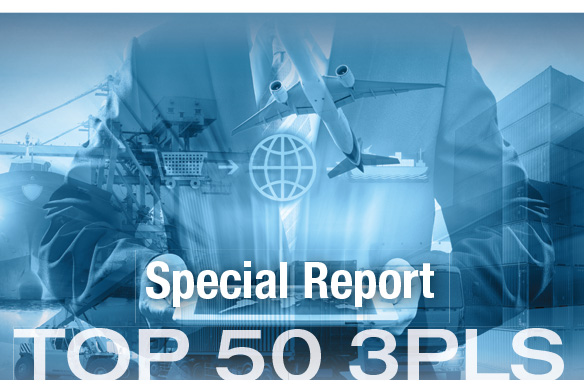Top 50 US and Global Third Party Logistics Providers (3PL) in 2017: Collaboration Is Now Paramount

As the e-commerce juggernaut creates more complexity for today’s logistics managers, finding the right mix of 3PLs with the essential integrated services has never been more important. Experts agree that this is a shared journey with new rules of engagement.
Industry insiders coming to grips with the dynamic changes shaping both the domestic and global third-party logistics (3PL) marketplace have come to similar conclusions about the future.
E-commerce continues to be the driving force for the Top 50 industry leaders, according the consultancy Armstrong & Associates. Meanwhile, merger and acquisition activity in the sector has been quieter than in recent years, but remains an attractive option for providers seeking to capitalize on synergies. For today’s logistics managers, finding the right mix of 3PLs offering the full gamut of integrated services to tackle e-commerce demands has never been more urgent, add market analysts.
“The biggest news on the integrated services front recently has been the explosive growth registered by the 3PL powerhouse XPO Logistics, which announced double-digit increases in its revenue this past spring,” notes Dick Armstrong, the consultancy’s chairman. He adds that it has left him a bit “chagrined” because he had been among the chief skeptics about the company’s aggressive strategy in the past.
“In retrospect, XPO was making the right moves all along,” says Armstrong. “They identified synergies that we had missed, and acquired 17 companies over the past six years.”
Indeed, spotting new trends in the 3PL arena both domestically and globally may yet become more challenging. Consider the ever-changing regulatory climate in the Asia Pacific, along with the gathering e-commerce storm breaking all over the world, one may only wonder how shippers will select the right partners in the future. Here’s a closer look at some of these key factors shaping today’s market and advice for navigating this complex new landscape.
Armstrong & Associates Top 50 U.S. 3PLs (April 2018) | ||
2017 Rank | Third-party Logistics Provider (3PL) | 2017 Gross Logistics Revenue |
1 | 14,869 | |
2 | 9,506 | |
3 | 7,981 | |
4 | 6,921 | |
5 | 6,828 | |
6 | 5,541 | |
7 | 4,390 | |
8 | 4,035 | |
9 | 3,396 | |
10 | 3,066 | |
11 | 3,014 | |
12 | 2,934 | |
13 | 2,915 | |
14 | 2,381 | |
15 | 2,360 | |
16 | 2,331 | |
17 | 2,330 | |
18 | 2,181 | |
19 | 2,094 | |
20 | 1,947 | |
21 | 1,943 | |
22 | 1,940 | |
23 | 1,910 | |
24 | 1,700 | |
25 | 1,536 | |
26 | Worldwide Express/Unishippers Global Logistics | 1,400 |
27 | 1,300 | |
28 | 1,297 | |
29 | 1,211 | |
30 | 1,200 | |
31 | 1,082 | |
32 | 1,029 | |
33 | 1,010 | |
34 | 1,000 | |
35 | 933 | |
36 | 920 | |
37 | 905 | |
38 | 900 | |
39 | 855 | |
40 | 854 | |
41 | 836 | |
42 | 800 | |
43 | 792 | |
44 | 790 | |
45 | 788 | |
46 | 773 | |
47 | 763 | |
48 | 740 | |
49 | 707 | |
50 | 661 | |
*Revenues are company reported or Armstrong & Associates, Inc. estimates and have been converted to US$ using the average annual exchange | ||
Armstrong & Associates Top 50 Global 3PLs (April 2018) |
||
2017 Rank | Third-party Logistics Provider (3PL) | 2017 Gross Logistics Revenue |
1 | 27,598 | |
2 | 22,574 | |
3 | 18,560 | |
4 | 16,720 | |
5 | 14,869 | |
6 | 11,374 | |
7 | 9,506 | |
8 | 7,981 | |
9 | 7,046 | |
10 | 6,994 | |
11 | 6,921 | |
12 | 6,834 | |
13 | 6,828 | |
14 | 6,255 | |
15 | 5,935 | |
16 | 5,621 | |
17 | 5,012 | |
18 | 4,740 | |
| 19 | 4,660 | |
20 | 4,454 | |
21 | 4,227 | |
22 | 4,035 | |
23 | 3,951 | |
24 | 3,914 | |
25 |
| 3,896 |
26 | 3,500 | |
27 | 3,396 | |
28 | 3,305 | |
29 | 3,066 | |
30 | 3,014 | |
31 | 2,934 | |
32 | 2,700 | |
33 | 2,548 | |
34 | 2,360 | |
35 | 2,330 | |
36 | 2,181 | |
37 | 1,947 | |
38 | 1,943 | |
39 | 1,940 | |
40 | 1,910 | |
41 | 1,864 | |
42 | 1,735 | |
43 | 1,700 | |
44 | 1,638 | |
45 | 1,632 | |
46 | 1,627 | |
47 | 1,565 | |
48 | 1,536 | |
49 | 1,501 | |
50 | 1,400 | |
**Revenues are company reported or Armstrong & Associates, Inc. estimates and have been converted to US$ using the average annual exchange rate in order to make non-currency related growth comparisons. Copyright © 2018 Armstrong & Associates, Inc. | ||
The Asia factor
For Evan Armstrong, the consultancy’s president, one of the chief takeaways from the firm’s most recent Top 50 global 3PL research was the dynamic role played the Asia Pacific (APAC) in the global arena. “Absent any new trade wars or regulatory upheaval, we believe APAC will continue to generate revenue and create opportunity for expansion in worldwide 3PL markets,” he says.
Should there be a sudden change in trade policies between the United States and major Asian partners, Armstrong feels that 3PLs will come to rely more on air cargo than ocean carriers for more agile adaptation. “With air cargo, a shipper can turn on a dime, whereas ocean carriage poses more supply chain complications,” he says. “In any case, we advise shippers to work with multiple providers, or at the very least, to rely on one with integrated services.”
Such advice may be of special interest to shippers in the reverse logistics and cold chain niche, adds Armstrong, since business models are especially vulnerable to sudden shifts in trade compliance. “However, it really comes down to e-commerce,” he says. “That’s the game-changer in APAC and everywhere else.”

The e-commerce factor
Just before Armstrong & Associates and the Global Supply Chain Council staged their annual “3PL Value Creation Asia Summit” in Hong Kong last month, the consultancy produced an exhaustive report titled “E-Commerce Logistics in the United States.” Taking a deep dive into the impact of e-commerce, the report examines domestic and international transportation, warehousing and fulfillment, last-mile delivery and reverse logistics.
“The well-traveled path from distribution center to store location is being replaced by a much more complex series of moves,” says Evan Armstrong. “Newly configured supply chains link distribution centers to fulfillment centers to parcel hubs and sortation centers to last-mile delivery providers for residential delivery. And as logistically complex product categories make the shift to e commerce, the extra mile is only becoming more cumbersome and costly.”
The e-commerce revolution has hardly escaped the attention of leading private equity firms as well. In a move perhaps signaling a new wave of merger and acquisition activity in the 3PL sector, the firm of Welsh, Carson, Anderson & Stowe recently formed a strategic partnership with a prominent industry veteran to spot candidates for purchase.
According to Randall Curran, the former CEO of Ozburn-Hessey Logistics (OHL) and consulting partner, this new venture shows exceptional promise. “Given the current environment of extreme volatility, the stakes have never been higher for 3PLs,” says Curran. “The volume of SKUs can be overwhelming, and the complexity has become much more pronounced.”
Curran led OHL through several years of sustained growth culminating in the sale of the company to Geodis in 2015. At the time of the sale, OHL had 120 value-added distribution centers in North America with more than 36 million square feet of warehouse space, along with 8,000 employees.
“There are quite a few very well run logistics companies that may wish to become part of a larger group,” says Curran, who adds that the partnership’s goal will be to leverage what makes each company successful while offering the market a more extensive “value proposition.”

A shipper’s “journey”
A new case study undertaken by Gartner and McDonald’s Corp. reveals that having “skin in the game” is essential for future collaboration. “A Shipper’s Journey to Achieve the 3PL Partnership Panacea,” presented at the recently concluded “Supply Chain Executive Conference” in Phoenix, provided a compelling argument for improved, dynamic partnerships.
According to David Gonzalez, a Gartner analyst, the investment in functional technology has always been important for both shippers and their 3PLs, but “value-added” technology is becoming increasingly vital. For example, shippers should expect daily forecasts with 99% reliability with shipments of perishables.
“Both shippers and their 3PLs need to invest in continual improvement while adhering to the time-benefit-maturity models,” says Gonzalez. “We view Kuhne + Nagle as one player that does not regard this kind of partnership as a theoretical exercise. They are moving beyond their assets to deliver their promises.”
Sue Fangmann, U.S. supply chain services director at McDonald’s, says that having a solid relationship with several 3PLs can help avoid a catastrophe similar to that of KFC in England earlier this year. “This is particularly true in the European Union where the pressure for land and warehouse utilization is far greater,” she says. Furthermore, she advises shippers to define the relationship from the outset and have an exit strategy if things don’t work out.
“Establishing cultural alignment between shipper and 3PL is a major challenge,” adds Gonzalez. “If you have that, the risk of ‘over-collaboration’ is reduced, and the shipper is more empowered.”
Avoiding supply chain breakdowns: Learning from the KFC debacle
What went wrong, and how can organizations prevent themselves from falling into the same trap?
The breakdown of Kentucky Fried Chicken’s supply chain in the United Kingdom in February 2018 provides a cautionary tale about hidden vulnerabilities in supply chains that all organizations should note.
Two-thirds of KFC’s nearly 900 UK locations were affected by the breakdown, which led to shortages of chicken, gravy, and many other supplies. Two months after the initial crisis, less than half of the locations were serving a full menu, according to HuffPost UK.
The situation has been more than just a PR and logistics nightmare for company executives. KFC’s parent company, Yum Brands, reported on May 2 that the supply chain problems would negatively affect earnings.
What went wrong, and how can organizations prevent themselves from falling into the same trap?
The key breakdown in the KFC supply chain centered around the food chain’s recent switch from a specialty food distributor to a mega-freight forwarder, which, like many third-party logistics (3PL) companies, owns very few physical assets. These 3PL companies rely on a complex patchwork of individual trucking companies and other carriers to deliver their service.
Organizations should take specific measures for creating visibility in the vendor supply chain when it is dependent on 3PL providers.
Companies should work with their 3PL partners to keep track of which carriers will be used for their shipments and ensure that their quality and security requirements are cascaded down to subcontractors in contractual language with the 3PL.
Companies should clearly define key performance indicators with the 3PL partner and minimum standards for carriers that they use.
Logistics buyers should conduct in-person checks of at least a slice of the 3PL partner’s subcontractors to directly check out their quality, business continuity, and security practices.
In addition, companies should work to identify where their supply chains run through regions that are vulnerable to disruptive local events and build in redundancy there to circumvent disruption or supply chain bottlenecks. Localized low-impact, high-likelihood events pose risks to supply chains around the world without making international news and can create “cascading risk” in which disruptions in one part of the supply chain create additional problems downstream.
Companies should speak with vendors about how local events affect them and what contingency plans they have in place, as well as engage with external geopolitical risk experts who can offer unbiased analysis and context.
Communication and cooperation between the teams examining the supply chain—business continuity, procurement, logistics, and so on—is essential to reduce silos and mitigate overall risk. While many organizations seek to simplify and streamline their supply chains to maximize efficiency and profitability, reducing redundancy can also introduce risk, fragility, and an increased potential for disruption.
Complex supply chains can hide diamond-shaped chains, in which most or all vendors source a component from a small group of suppliers. For example, dye pigments used in many manufacturing industries are only made by a few factories in one region of Japan. A natural disaster in that region that halted production would disrupt all industries that use that pigment.
Having one company coordinate all activity can lead to an onion-like structure of contracting and subcontracting that reduces visibility into who is actually carrying a company’s cargo at any point in time. This increases the difficulty of ensuring quality and security through the distribution chain.
In some cases, it may be more sustainable in the long term to work with a roster of several approved logistics companies, granting delivery lanes to each one depending on where their networks are the most dense and robust. Companies can then compare performance across lanes and re-allocate them as the better performing providers rise to the top.
Working with multiple logistics providers serves as a sort of insurance policy. In case there is a business continuity issue with one of them, one (or several) of the others may be able to fill in.
If you take basic precautions to protect the integrity of your supply chain today, your organization will be more likely to operate uninterrupted—preventing future headaches and negative headlines in the future
3PLs as business intelligence leaders
At the same time, other industry analysts and trade associations are making a case for 3PLs to take on more of a leadership role in capturing market intelligence.
According on Chris Burroughs, senior director of government affairs for the Transportation Intermediaries Association (TIA), 3PLs are digging deeper into data and analytics to help logistics managers keep pace with today’s volatile marketplace. “Simultaneously, 3PLs may find themselves shouldering a greater responsibility to spot and suggest opportunities for overall operational changes—even outside the supply chain—that benefit shippers,” he says.
Coinciding with TIA’s annual conference held in Palm Desert, Calif., last April was the release of its “2018 Freight Visibility Report.” Drawn from interviews with the largest 3PLs, as well as smaller technology leaders, the report goes into some detail on how and why increased freight visibility may be creating significant value in today’s disruptive business landscape.
“We were interested to hear from both shippers and 3PLs about the constantly evolving process that depends heavily on the technology,” says Burroughs. “Leadership in this arena makes sense because 3PLs are in a position to provide the specific data unique to any one shipper.”
Noël Perry, transportation economist and principal with the consultancy Transport Futures, agrees, noting that the real potential for “transport visibility” in supply chain design is becoming more complicated. “Now transport largely conforms to the other elements,” he says. “As they find out how much they affect cost and service, 3PLs will increasingly adapt.”
Perry adds that significant advances in visibility technologies have created a wide range of perceptions and expectations among shippers—including some that are inaccurate.
Rafael Duarte Alcoba and Kenneth W. Ohlund, graduate students at the MIT Center for Transportation & Logistics, come to many of the same conclusions as Perry in their recent study titled “Capturing the Value of Predictive Modeling in Logistics.”
The research team recently developed a logistics “regression model” for a 3PL based on a historical data set it provides and then indicates which loads are likely to be delayed. They state that “by tracking only loads dictated by the model, the company can achieve significant resource reduction.”
In the past, a lack of data and inadequate processing power rendered predictive analytics infeasible, the study contends. But as technology and innovation drive forward, methods facilitating the use of mathematical tools for predictions improve: “Data collection and computing power are two key areas where improvements are changing the landscape of predictive applications. The Internet of Things (IoT) and Cloud storage have transformed data collection and storage capacity.”
The move to Cloud-based technology is also making supply chain platforms more accessible for smaller 3PLs, says Jon Slangerup, CEO of American Global Logistics (AGL). He adds that modest-sized 3PLs like AGL are often naturally more agile than their enterprise counterparts, and still have the right tools to provide the shipper with a competitive edge against the big guys.
“A partner with a wide logistics network who understands your workflows makes all the difference if you need to find capacity quickly or navigate a Customs issue,” says Slangerup. “And with new technologies like AI and blockchain getting enormous buzz, a provider should be able to separate the real from the hype and guide them on what’s relevant for their own management of logistics.”













